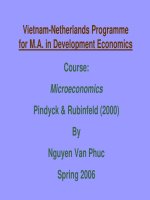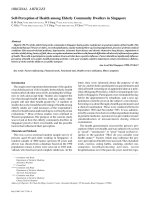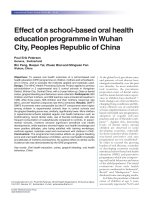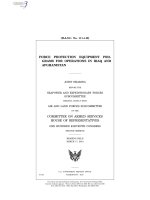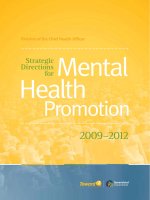Oral health promotion programme for diabetics in singapore
Bạn đang xem bản rút gọn của tài liệu. Xem và tải ngay bản đầy đủ của tài liệu tại đây (813.71 KB, 276 trang )
ORAL HEALTH PROMOTION PROGRAMME FOR
DIABETICS IN
SINGAPORE
HLA MYINT HTOON
NATIONAL UNIVERSITY OF SINGAPORE
2006
ORAL HEALTH PROMOTION PROGRAMME FOR DIABETICS IN
SINGAPORE
HLA MYINT HTOON
(B.D.S.)(F.I.C.D.)
A THESIS SUBMITTED
FOR THE DEGREE OF DOCTOR OF PHILOSPHY
FACULTY OF DENTISTRY, PREVENTIVE DENTISTRY
DEPARMENT
NATIONAL UNIVERSITY OF SINGAPORE
2006
THIS THESIS IS DEDICATED TO
MY FAMILY
MY DEAR WIFE “Sanda” & DAUGHTER “Phyu”
AND
IN MEMORY OF
MY DEAR PARENTS
“Col. Tan Yu Saing & Daw Hla Hla”
&
DAUGHTER
“Lynne”
ii
DECLARATION
This thesis does not contain material that has been submitted for any degree or
qualification, or published work by another person with the exception of citations
acknowledged in the text.
HLA MYINT HTOON
DATE: 20.01.06
iii
ACKNOWLEDGEMENTS
I would like to extend my deepest appreciation, for the kind guidance and encouragement
rendered by my supervisor Assoc. Professor Lim Lum Peng with her astute mentoring and
unwavering perseverance to support my academic progress.
My deepest appreciation also goes to Dr Fidelia Tay for providing all the support in her
capacity to conclude this research.
I would like to express my special thanks to Dr. Sum Chee Fang and Prof. Thai Ah Chuan
for the multidisciplinary collaboration and support for the success of the study. I would
like to express my special thanks to both the consultants for providing this immeasurable
contribution.
Special appreciations are also extended to Dr. Chan Yiong Huak, for his special guidance
in the statistical analysis of this complex study and to Dr. Roland Jureen for proofreading
and invaluable suggestions provided.
Last but not the least, my colleagues Dr. Khurram Ataullah, Dr Tan Wah Ching, Dr Chee
Hoe Kit and Dr.Tan Ching Ching deserve my special thanks for their help, encouragement
and friendship.
iv
Table of Contents
Dedication…………………………………………………
i
Declaration………………………………………………… ii
Acknowledgements.…………………………………………. iii
Table of contents……………………………………………. iv
Summary xii
List of Tables……………………………………………… xv
List of Figures ………………………………………………
xxi
List of Appendices………………………………………… xxii
1.0 Introducing background to research……………… 1
2.0 Literature review…………………………………… 4
2.1 Diabetes –The size of the problem………………… 4
2.2 Epidemiology of Periodontal disease……………… 6
2.2.1 Assessment of Periodontal disease………………… 6
2.2.2 Prevalence of Periodontal disease-Local & Global
trend………………………………………………….
8
2.3 Association between Periodontal disease and
Diabetes………………………………………………
10
2.3.1 Diabetes as a risk factor for periodontal disease…. 10
2.3.2 Pathogenic mechanisms……………………………. 14
2.3.3 Periodontal treatment response…………………… 19
2.4 Role of Non-surgical periodontal therapy and
Diabetes………………………………………………
23
v
2.4.1 Scaling, root planing and polishing……………… 23
2.4.2 Role of Oral Hygiene in non-surgical therapy… 24
2.5 Factors affecting implementation of oral plaque
control and oral hygiene maintenance………
26
2.5.1 Self- system, perception & value………………… 27
2.5.2 Oral hygiene compliance…………………………… 27
2.5.3 Non-adherence as a risk factor…………………… 31
2.5.4 Psychosocial determinants…………………………. 32
2.5.5 Other considerations……………………………… 33
2.6 Oral health behavioural models and the implications
on oral health………………………….
35
2.6.1 Introduction………………………………………… 35
2.6.2 Concepts and constructs of health behaviour…… 36
2.6.3 Theories/Models of health behaviour…………… 36
1. Health belief model………………………………. 37
2. Theory of reasoned action……………………… 38
3. Social Cognitive Theory…………………………. 40
4. Self-efficacy Theory……………………………… 40
5. Transtheoretical model or Stages of Changes
Theory…………………………………………….
42
6. Locus of Control Theory………………………… 43
7. New Century Model……………………………… 44
8. PRECEDE-PROCEED Model………………… 45
9. Knowledge, Attitude and Practice (KAP)……… 47
vi
2.7 Studies on oral health attitudes and behaviours…
49
2.7.1 Oral health attitudes……………………………… 49
2.7.2 Oral health behaviour……………………………… 50
2.7.3 Knowledge………………………………………… 51
2.7.4 Oral health behaviour in relation to diabetes
control and complications…………………………
52
2.8 Measurement of oral health behaviour and oral
health related quality of life………………………
55
2.8.1 Behaviour Inventory……………………………… 55
2.8.2 Oral health quality of life…………………………… 56
2.9 Research questions, basis for analysis & analytical
model………………………………………………….
58
2.9.1 Statement of the Problems………………………… 58
2.9.2 Aims and Objectives………………………………… 62
3.0
MATERIALS & METHODS…………………………….
63
3.1 Background and settings to research………………. 63
3.2 Research hypotheses………………………………… 63
3.2.1 Hypotheses…………………………………………… 63
3.3 Justification………………………………………… 64
3.4 Scope and key assumption………………………… 65
3.5 The sample population……………………………… 65
3.6 Ethical considerations……………………………… 66
3.6.1 Plan for protection of human subjects…………… 66
3.7 Research procedures and methodology……………. 66
vii
3.7.1 Study design…………………………………………. 66
3.7.2
Intervention strategies……………………………… 67
3.7.3 Action plan of activities…………………………… 67
3.7.4 Inclusion criteria…………………………………… 68
3.7.5 Exclusion criteria…………………………………… 69
3.7.6 Randomization……………………………………… 69
3.7.7 Clinical Parameters………………………………… 69
3.7.8 Clinical Intervention………………………………… 71
3.7.9 Questionnaires………………………………………. 71
3.7.10 Laboratory parameters…………………………… 74
3.8 Analysis of data……………………………………… 75
3.8.1 Introduction………………………………………… 75
3.8.2 Statistical Plan……………………………………… 75
4.0
RESULTS………………………………………………
83
4.1 Assessment of oral hygiene compliance and
associated factors before intervention………………
83
4.1.1 Demographic Data………………………………… 83
4.1.2 Diabetic Status………………………………………. 85
4.1.3 Clinical and laboratory data……………………… 88
4.1.3.1 Denture Status……………………………………… 91
4.1.4 KAP Questionnaire at Baseline…………………… 91
4.1.4.1 Knowledge of cause of gum disease………………… 91
Risk Perception…………………………………… 92
viii
4.1.4.2 Oral health practices at baseline……………………. 93
Toothbrushing practice…………………………… 93
Interdental cleaning practice……………………… 93
Dental Visits…………………………………………. 94
Smoking habit among diabetics……………………. 94
4.1.4.3 Attitudes…………………………………………… 95
Oral health impact profile………………………… 95
Hiroshima University –Dental behaviour Inventory
(HU-DBI)……………………………………………
99
4.1.5 Health Behaviour……………………………………. 100
Factor Analysis………………………………………. 101
4.1.6 Assessment of Oral Hygiene Compliance………… 105
Receiver Operator Characteristic Curve Analysis
105
4.2 Assessment of intervention strategy on outcomes in
comparison to baseline with 3 and 9 months data….
108
4.2.1 Effect of intervention on oral health knowledge… 108
Knowledge of cause of gum infection………………. 108
4.2.2 Effect of intervention on oral health practice……… 109
Acceptable interdental cleaning…………………… 109
4.2.3 Effect of intervention on attitudes………………… 111
OHIP-14……………………………………………… 111
OHIP-14 trend in relation to oral hygiene
behaviour……………………………………………
118
HU-DBI……………………………………………….
121
ix
HU-DBI trend in relation to oral hygiene
behaviour…………………………………………….
127
4.2.4 Effect of intervention on laboratory data………… 129
HbA1c……………………………………………… 129
Total cholesterol…………………………………… 130
4.2.5 Effect of intervention on periodontal parameters… 130
Plaque………………………………………………… 130
BOP………………………………………………… 132
Subgingival calculus………………………………… 134
Supraginigival calculus…………………………… 136
Probing pocket depth……………………………… 136
4.2.6 Effect of intervention on oral hygiene compliance
138
Oral hygiene compliance criterion
(within group comparison)………………………….
138
Oral hygiene compliance criterion
(between group comparison)………………………
144
Oral hygiene compliance subcategories…………… 146
Logistic regression analysis………………………… 148
Multinomial regression analysis…………………… 149
4.2.7 Self-efficacy………………………………………… 151
Toothbrushing Self-efficacy………………………… 151
Interdental cleaning Self-efficacy………………… 151
Dental Visit Self-efficacy……………………………. 152
Oral Health Belief Self-efficacy…………………… 152
x
Diabetes control Self-efficacy……………………… 152
4.3 Analysis of multifactorial factors affecting oral
hygiene compliance by SEM……………………….
160
4.3.1 The model………………………………………… 162
4.3.2
SEM (pathway analysis)………………………… 165
4.3.3 SEM (results)………………………………………. 167
5.0 DISCUSSION………………………………………… 171
5.1 Assessment of oral hygiene compliance and
associated factors……………………………………
171
5.1.2 Knowledge on cause of periodontal disease………. 171
Baseline……………………………………………… 171
Post-intervention……………………………………. 172
5.1.3 Attitudes…………………………………………… 172
OHIP-14……………………………………………… 172
Baseline………………………………………………. 173
Post-intervention…………………………………… 173
HU-DBI………………………………………………. 176
Baseline……………………………………………… 176
Post-intervention……………………………………. 176
5.1.4 Oral Health Practices……………………………… 178
Acceptable interdental cleaning…………………… 178
Baseline……………………………………………… 178
Post-intervention…………………………………… 179
Dental visits………………………………………… 180
xi
Health behaviour…………………………………… 180
Oral Hygiene Compliance Criterion……………… 181
5.2 Assessment of intervention strategy on clinical &
laboratory parameters……………………………
184
Clinical parameters………………………………… 184
Plaque………………………………………………… 184
BOP…………………………………………………… 185
Probing pocket depth……………………………… 185
Subgingival calculus…………………………………. 186
Cochrane report…………………………………… 186
Laboratory parameters…………………………… 188
HbA1c………………………………………………… 188
Total cholesterol…………………………………… 188
5.3 Factors associated with oral hygiene compliance…. 189
5.3.1 Treatment modalities……………………………… 190
5.3.2 Subgingival calculus…………………………………. 191
5.3.3 Self-efficacy………………………………………… 192
5.3.4 HbA1c………………………………………………… 195
5.3.5 Behaviour related variables………………………… 195
5.4 Limitations of the study…………………………… 196
6.0 CONCLUSION………………………………………. 199
References…………………………………………… 202
Appendices………………………………………… 230
xii
SUMMARY
Aim: The purpose of this study was to evaluate the periodontal status of a cohort of
patients with diabetes in a longitudinal randomized controlled trial and to find out the
factors affecting the treatment outcome in terms of clinical, laboratory and oral hygiene
compliance behavioural responses.
Materials and methods: 161 subjects with diabetes were recruited from two diabetic
centres in Singapore. These subjects were then randomized into three groups; oral hygiene
with scaling group OH+Sc (59 subjects), oral hygiene alone group OH (52) and control
group (50). At baseline, periodontal clinical parameters, Probing Pocket Depth (PPD),
Plaque, Bleeding on Probing (BOP) and Calculus) were collected. Laboratory data
(HbA1c, Total cholesterol) and self reported questionnaire data; Knowledge, Attitude and
Practice (KAP), Hiroshima University Dental Behaviour Inventory (HU-DBI) and Oral
Health Impact Profile 14 items (OHIP-14) were collected prior to the intervention. Oral
hygiene instruction was delivered to the subjects belonging to OH+Sc & OH groups.
Scaling was only provided to the OH+Sc group and the control group did not receive any
form of therapy. The same parameters were evaluated at 3 months (155 subjects) and 9
months (132 subjects) with an additional questionnaire set on self-efficacy at 9 months.
To determine a criterion for oral hygiene compliance (OHC), Receiver Operator
Characteristic (ROC) curve analysis was carried out using a sequence of plaque and BOP
scores in relation to a composite score of pocket depth, subgingival calculus and
supragingival calculus at baseline. McNemar, logistic regression analysis and Pearson’s
xiii
Chi Square test with Bonferroni correction was used to analyze the OHC criterion
differences. ANOVA, ANCOVA and repeated measure analysis was used for analyzing
clinical and laboratory data differences. Summation scores of Questionnaire data were
analyzed by ANOVA and paired t tests. An “ a priori’ OHC model was analyzed for a
path analysis (Structural Equation Modeling).
Results: The combination of ≥ 25% plaque scores and ≥ 15% gingival bleeding scores
(unacceptable oral hygiene compliance criterion) obtained the highest Receiver Operator
Characteristic (ROC) value (using a probability cutoff of 0.5) of 0.868 with Sensitivity
98.6%, Specificity 75.0%, Positive Predictive Value (PPV) 97.3% and Negative Predictive
Value (NPV) 85.7%. After intervention, OHC for OH +Sc group showed significant
improvements compared to control at 3 months (p<0.001) and 9 months (p<0.01). OH
group showed a significant improvement compared to Control at 9 months (p<0.01) only.
The OH+ Sc group was found to have significantly lower plaque, BOP and subgingival
calculus levels as compared with Control group at 3 months (p<0.01) and at 9 months
(p<0.01). OH group showed significant reductions in plaque and BOP scores at 3 months
(p<0.05) and at 9months for plaque only (p<0.05). There were no significant change in
PPD, HbA1c, total cholesterol and supragingival calculus variables at all time lines
between groups. There were no marked change in knowledge of periodontal disease
among the oral hygiene instructed groups, however, there were significant improvements
in interdental cleaning practice for the OH+Sc group compared to control at 3 months
(p<0.05). There was no marked change in oral health attitudes or the oral health impact
profile following intervention. A logistic regression analysis showed self-efficacy as a
potential explanatory theory for oral hygiene compliance behaviour among this cohort
(p<0.01). Subgingival calculus and unacceptable HBA1c at baseline were factors found to
xiv
be associated with low oral hygiene compliance (p<0.05) using structural equation
modeling (SEM).
Conclusion: In conclusion, the study confirms that scaling and oral hygiene education is
an effective periodontal treatment modality to improve periodontal health of patients in
the programme. The removal of subgingival calculus in combination with oral self-care is
considered to be the treatment of choice for managing periodontal disease among subjects
with diabetes. In addition, enhancing self-efficacy and effective control of HbA1c may
have beneficial effects on oral hygiene compliance for diabetics in Singapore.
xv
List of Tables
Table 1 Age specific prevalence of diabetes (%) in
Singapore
5
Table 2 Comparison of %CPI scores among children, adult and
diabetics in Singapore……………………………………
9
Table 3 Studies of diabetes as a risk factor for periodontal disease
11
Table 3.1 Effect of periodontal therapy on periodontal
parameters and glycaemic control…………………
21
Table 4 Elements of various theories and models for Oral Health
Promotion………………………………………………….
48
Table 5 Oral health promotion programmes on patients with
diabetes……………………………………………………
53
Table 6 Subjects by groups at baseline, 3 months and 9 months
83
Table 6.0.1 Subjects by gender and ethnicity at baseline…………
84
Table 6.0.2 Subjects by gender and ethnicity at 3 months………
84
Table 6.0.3 Subjects by gender and ethnicity at 9 months…………
84
Table 6.0.4 Subjects by age groups at baseline………………….…
84
Table 6.0.5 Subjects by age groups at 3 months……………………
85
Table 6.0.6 Subjects by age groups at 9 months……………………
85
Table 6.1 Duration of diabetes by gender…………………………
86
Table 6.2 Duration of diabetes by ethnicity………………………
86
Table 6.3 Duration of diabetes by age category……………………
86
Table 6.4 Duration of diabetes by treatment groups………………
87
Table 6.5 Activities related to diabetes control…………………….
87
Table 7.0 Mean number of teeth at baseline by groups…………
88
Table 7.1 Mean HbA1c levels at baseline…………………………
89
xvi
Table 7.2 Mean Total cholesterol levels at baseline………………
89
Table 7.3 Mean % plaque levels at baseline………………………….
89
Table 7.4 Mean % BOP levels at baseline……………………………
90
Table 7.5 Mean % supragingival calculus levels at baseline…………
90
Table 7.6 Mean % subingival calculus levels at baseline……………
90
Table 7.7 Mean pocket probing depth(PPD) levels at baseline…….
91
Table 8.1 Response by groups on cause of gum disease due to
ineffective oral hygiene (baseline)………………………
92
Table 8.2 Response by groups on cause of gum disease due to
bacterial dental plaque (baseline)………………… ……
92
Table 9 Number of Interdental device used…………………………
93
Table 10 Reasons given for dental attendance……………………
94
Table 11 Baseline Frequency distribution of OHIP-14……………
96
Table 11.1 Frequency distribution of OHIP-14S item responses
97
Table 11.2 Mean scores and internal consistency for OHIP-14S and
individual subscales at baseline…………………………
98
Table 11.3 Self-reported symptoms over 3 months and oral health
related quality of life…………………………………….
99
Table 12.1 Frequency distribution of health questionnaire………
102
Table 12.2 Frequency distribution of energy related questionnaires
102
Table 12.3 Frequency distribution of healthy life style questionnaire
103
Table 12.4 Frequency distribution stress related questionnaires…
103
Table 12.5 Varimax rotated factor structure of health related
questionnaire…………………………………………….
104
Table 13.1 ROC: Area under the curve assessment from different oral
hygiene cutoff levels…………………………………….
106
xvii
Table 13.2 Sensitivity, Specificity, Positive Predictive Value, Negative
Predictive Value from different oral hygiene compliance
cutoff levels………………………………………………….
107
Table 14.1 Comparison response to cause of gum disease: baseline and
3 months………………………………………………………
108
Table 14.2 Response by groups for cause of gum disease due to
ineffective oral hygiene……………………………………
109
Table 14.3 Response by groups for cause of gum disease due to
bacterial dental plaque (3 months)…………………………
109
Table 15.1 Comparison of acceptable interdental cleaning between
baseline and 3 months………………………………………
110
Table 15.2 Comparison of number of interdental device usage at
baseline and 3 months………………………………………
110
Table 15.3 Acceptable interdental (floss+interbrush) usage mean sum
scores between baseline and 3 months…………………….
111
Table 15.4 Between group comparison at 3 months for acceptable
interdental usage……………………………………………
111
Table 16.1 Frequency distribution of OHIP-14 at 9 months…………
114
Table 16.2 Comparison of OHIP-14 sum score between baseline and 9
months………………………………………………………
115
Table 16.3 Frequncy distribution OHIP-14S items responses
at 9 months………………………………………………….
115
Table 16.4 Mean scores and internal consistency for OHIP-14S and
individual subscales at 9 months…………………………
116
Table 16.5 Mean scores OHIP-14S differences between baseline and
9 months…………………………………………………….
116
Table 16.6 Functional Limitation subscale within group comparison
116
Table 16.7 Physical pain subscale within group comparison………
117
Table 16.8 Psychological discomfort subscale within group
comparison………………………………………………….
117
xviii
Table 16.9 Physical disability subscale within group comparison……
117
Table 16.10 Psychological disability subscale within group comparison
118
Table 16.11 Social disability subscale within group comparison…….
118
Table 16.12 Handicap subscale within group comparison……………
118
Table 16.13 Summary table for OHIP- 14 difference
(ordinal regression)………………………………………
120
Table 17.1 Reliability analysis of HU-DBI at baseline………………
122
Table 17.2 Reliability analysis of 9 months HU-DBI…………………
123
Table 17.3 Frequency distribution of HU-DBI 13 item sum scores at
baseline…………………………………………………….
125
Table 17.4 Frequency distribution of HU-DBI 13 item sum scores at 9
months………………………………………………………
126
Table 17.5 HU-DBI 13 items difference between groups at baseline
127
Table 17.6 Summary table for HU-DBI 13 items difference
(ordinal regression)………………………………………
128
Table18.1 Comparison of mean HbA1c at baseline, 3months and 9
months……………………………………………………
129
Table 18.2 Comparison of distribution of acceptable (HbA1c) and
unacceptable at baseline, 3months and 9 months……….
129
Table 18.3 Comparison of mean cholesterol at baseline, 3months and
9 months…………………………………………………….
130
Table 18.4 Plaque difference between groups at baseline……………
130
Table 18.5 Plaque % mean difference between groups from baseline
at 3 months and 9 months………………………………….
131
Table 18.6 Within group comparison of Plaque at 3 months and 9
months from baseline………………………………………
132
Table 18.7 BOP difference between groups at baseline………………
132
Table 18.8 BOP % mean difference between groups from baseline at
3 months and 9 months……………………………………
133
xix
Table 18.9 Within group comparison of BOP at 3 months and 9
months from baseline……………………………………
133
Table 18.10 Subgingival calculus difference between groups at
baseline…………………………………………………….
134
Table 18.11 Subgingival calculus % mean difference between groups
from baseline at 3 months and 9 months………………
135
Table 18.12 Within group comparison of % subgingival calculus at 3
months and 9 months from baseline…………………….
135
Table 18.13 Within group comparison of % supragingival calculus at
3 months and 9 months from baseline………………
136
Table 18.14 PPD difference between groups at baseline……………….
136
Table 18.15 PPD % mean difference between groups from baseline at
3 months and 9 months……………………………………
137
Table 18.16 Within group comparison of PPD at 3 months and 9
months from baseline………………………………………
137
Table 19.1 OHC criterion 25-15 at baseline, 3months and 9 months
138
Table 19.2 Oral Hygiene Compliance (25-15) comparison between
baseline and 3months, 9months (whole study group)…
139
Table 19.3 Comparison of Oral Hygiene Compliance (25-15) at
baseline and 3 months, 9 months (within gender groups)
140
Table 19.4 Comparison of Oral Hygiene Compliance (25-15) at
baseline and 3 months, 9 months (within ethnic groups)
140
Table 19.5 Comparison of Oral Hygiene Compliance (25-15) at
baseline and 3 months, 9 months (within age groups)
141
Table 19.6 Oral Hygiene Compliance (25-15) comparisons between
baseline and 3 months, 9 months (within each group)
142
Table 19.7 Baseline group differences for OHC noncompliance using
logistic Regression…………………………………………
144
Table 19.8 Comparison of Oral Hygiene Compliance (25-15) at
baseline and 3 months, 9 months by treatment modality
145
Table 19.9 Unacceptable OHC (3 months) by gender………………
146
xx
Table 19.10 Comparison of OHC categories (baseline, 3 months, and
9 months)…………………………………………………
147
Table 19.11 Comparison of OHC categories (baseline, 3 months,
9 months) groups………………………………………….
147
Table 19.12 Summary table for OH noncompliance (9 months)using
logistic regression…………………………………………
149
Table 19.13 Summary table for OH noncompliance categories
( 9 months) Multinomial regression…………………….
150
Table 20.1 Frequency distribution of Self-efficacy (tooth brushing)…
153
Table 20.2 Frequency distribution of Self-efficacy
(interdental cleaning)……………………………………….
153
Table 20.3 Frequency distribution of Self-efficacy (dental visit)…….
154
Table 20.4 Frequency distribution of Self-efficacy (oral health belief)
154
Table 20.5 Frequency distribution of Self-efficacy (diabetes control)
155
Table 20.6 Summation scores for Self-efficacy………………………
156
Table 20.7 Summation scores for Dental Self-efficacy and
Self-efficacy ( health behaviour)…………………….……
157
Table 20.8 Summation scores for Dental Self-efficacy and
Self- efficacy by groups…………………………………….
157
Table 20.9 Self-reported practices and Self-Efficacy sum scores t test
158
Table 20.10 Frequency of Self-efficacy categories in quartiles………
159
Table 21. Pathway analysis of Oral hygiene compliance
model………………………………………………………
170
xxi
List of Figures
Figure 1. Pathogenic mechanism of periodontal disease & diabetes
18
Figure 2. Flow Chart of Oral Health Promotion Programme Study 68
Figure 3. Statistical Analysis Flow Chart…………………………
82
Figure 4. ROC curve analysis of oral hygiene compliance…………. 107
Figure 5. Oral Hygiene Compliance 9 months Scatterplot (OH+Sc) 143
Figure 6. Oral Hygiene Compliance 9 months Scatterplot (OH)……
143
Figure 7. Oral Hygiene Compliance 9 months Scatterplot (Control)
143
Figure 8. Oral Hygiene Compliance Theoretical Model…………
164
xxii
List of Appendices
Appendix A. Patient Information Sheet & Consent form
230
Appendix B. Baseline Questionnaire…………………… 235
Appendix C. Review Questionnaire (3 months)………… 241
Appendix D. Health Questionnaire……………………… 244
Appendix E. HU-DBI Questionnaire…………………… 247
Appendix F. OHIP-14 Questionnaire…………………… 248
Appendix G. Self-efficacy Questionnaire………………. 249
1
CHAPTER ONE Introducing Background to the Research
Diabetes mellitus (DM) is one of the most common chronic medical conditions requiring
continued life-long management that affects a significant proportion of the adult
population in Singapore. Currently there are more than 300,000 people with diabetes in
Singapore reflecting a high prevalence of the disease in global standing (Cockram, 2000).
Poor glycaemic control in these patients have led to serious medical complications such as
blindness, kidney failure, heart attacks, strokes, limb amputation, sexual difficulties and
neurological complications. The increase in incidence of diabetes and its complications
calls for more concerted efforts to reduce the risk factors associated with the disease. This
includes maintenance of low blood glucose levels, control of cholesterol, hypertension,
body weight management and smoking cessation as a holistic approach involving the
various medical disciplines. With emerging emphasis on the link between periodontal
disease and systemic health, periodontal disease has been identified as the sixth
complication of diabetes (Löe, 1993). In Singapore, a pilot study conducted by Lim & co-
workers (2002) demonstrated a higher prevalence of periodontal disease amongst diabetics
as compared with the population at large. It is therefore timely to include periodontal
health care as part of the integral component of health promotion among patients with
diabetes.
Conventional measures used to control periodontal disease includes a combination of oral
hygiene and non-surgical periodontal therapy such as scaling and root planing to remove
plaque retention factors to prevent progression of periodontal disease (Jones & O’Leary,
1978; Axelsson & Lindhe, 1981; Nakib et al., 1982; Corbet et al., 1993). The
